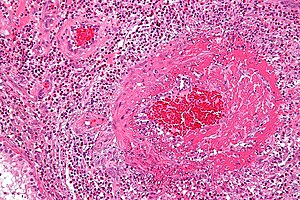Eosinophilic granulomatosis with polyangiitis
| Eosinophilic Granulomatosis with Polyangiitis [EGPA] | |
|---|---|
 |
|
| Micrograph showing an eosinophilic vasculitis consistent with Churg–Strauss syndrome. H&E stain. | |
| Classification and external resources | |
| Specialty | rheumatology |
| ICD-10 | M30.1 |
| ICD-9-CM | 446.4 |
| DiseasesDB | 2685 |
| eMedicine | med/2926 derm/78 neuro/501 |
| Patient UK | Eosinophilic granulomatosis with polyangiitis |
| MeSH | D015267 |
Eosinophilic granulomatosis with polyangiitis (EGPA; also known as Churg-Strauss syndrome [CSS] or allergic granulomatosis) is a rare autoimmune condition that causes inflammation of small and medium-sized blood vessels (vasculitis) in persons with a history of airway allergic hypersensitivity (atopy).
It usually manifests in three stages. The early (prodromal) stage is marked by airway inflammation; almost all patients experience asthma and/or allergic rhinitis. The second stage is characterized by abnormally high numbers of eosinophils (hypereosinophilia), which causes tissue damage, most commonly to the lungs and the digestive tract. The third stage consists of vasculitis, which can eventually lead to cell death and can be life-threatening.
This condition is now called "eosinophilic granulomatosis with polyangiitis" to remove all eponyms from the vasculitides. To facilitate the transition, it was referred to as "eosinophilic granulomatosis with polyangiitis (Churg-Strauss)" for a period of time starting in 2012. Prior to this it was known as "Churg-Strauss syndrome", named after Drs. Jacob Churg and Lotte Strauss who, in 1951, first published about the syndrome using the term "allergic granulomatosis" to describe it. It is a type of systemic necrotizing vasculitis.
Effective treatment of EGPA requires suppression of the immune system with medication. This is typically glucocorticoids, followed by other agents such as cyclophosphamide or azathioprine.
...
Wikipedia
